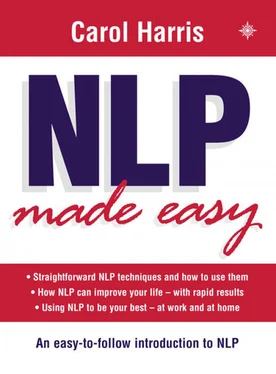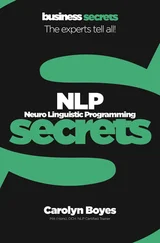Carol Harris
NLP
made easy
An easy-to-follow introduction to NLP
Cover
Title Page Carol Harris NLP made easy
Preface Preface My first encounter with NLP was reading the book which many other people had also acquired as their primer – Frogs into Princes . This book was both fascinating and confusing; it left many questions unanswered, as it was as a transcript of training rather than a stand-alone publication. However, for me, it was the impetus to further study and led to my professional life having a major focus on NLP. If this book adds to the store of available knowledge on the subject of NLP, I hope it does so utilizing two concepts which have been important to me personally: structure and simplicity. I have aimed to make the book as straightforward as is possible; I have also aimed to use a structure which is easy to follow and where specific items can be pursued without having to wade through irrelevancies and jargon. I would like to suggest a key in reading this book – and that is curiosity. Curiosity has long been a cornerstone of NLP. Attitudes of curiosity and exploration have led to the major developments which established NLP as a field in its own right and it is those same attitudes which continue to inform its progress. I would encourage you to approach each section of the book with these attitudes. Once you have read the book, it would be excellent if you could take the attitudes of curiosity and exploration forward into your life, extending your own personal search for knowledge, experience and creativity.
Finding your Way around this Book
Section One
1. What is Neuro-Linguistic Programming?
2. The History of NLP
3. Frameworks, Models and Techniques
Section Two
4. Personal Growth
5. Social Relationships
6. Work and Business
Appendices
Further Information
Training in NLP
Contact with Others Involved in NLP
Glossary of NLP Terms
Bibliography and Other Resources
Useful Contact Details
Index
Acknowledgements
About the Author
Copyright
About the Publisher
My first encounter with NLP was reading the book which many other people had also acquired as their primer – Frogs into Princes . This book was both fascinating and confusing; it left many questions unanswered, as it was as a transcript of training rather than a stand-alone publication. However, for me, it was the impetus to further study and led to my professional life having a major focus on NLP.
If this book adds to the store of available knowledge on the subject of NLP, I hope it does so utilizing two concepts which have been important to me personally: structure and simplicity. I have aimed to make the book as straightforward as is possible; I have also aimed to use a structure which is easy to follow and where specific items can be pursued without having to wade through irrelevancies and jargon.
I would like to suggest a key in reading this book – and that is curiosity. Curiosity has long been a cornerstone of NLP. Attitudes of curiosity and exploration have led to the major developments which established NLP as a field in its own right and it is those same attitudes which continue to inform its progress. I would encourage you to approach each section of the book with these attitudes. Once you have read the book, it would be excellent if you could take the attitudes of curiosity and exploration forward into your life, extending your own personal search for knowledge, experience and creativity.
Finding your Way around this Book
Welcome to NLP Made Easy . There are many books on NLP, but what I have aimed at here is to provide a structured guide to the various elements of the topic. For the first time, there is a history of NLP in the UK; most published material has been based on the early origins of NLP in the United States, but it has a sound base in the UK, which deserves to be recorded. For this part of the book I am indebted to the writers who have submitted articles to Rapport (the magazine of the Association for Neuro-Linguistic Programming, of which I am the editor), giving their thoughts on the early days of NLP in the UK. I have also aimed to give a rather more detailed explanation of some of the NLP terms than is generally found in book glossaries. NLP can be very jargon-filled, which is perhaps understandable, given its history, but it can easily be practised without the use of complex terminology. However, given that that terminology is part of the inheritance of NLP, in the last section of the book I have provided some simple examples which I hope flesh out the basic terms in an understandable way.
The book is in three main parts:
 Section One is about the origins and development of NLP and contains information on its history, notable people involved in its early development, and models, frameworks and techniques associated with it.
Section One is about the origins and development of NLP and contains information on its history, notable people involved in its early development, and models, frameworks and techniques associated with it.
Section Two is about how you can apply NLP in your own life. This section includes three broad areas: personal growth, social relationships and business situations.
The appendices outline practical steps you can take if you wish to find out more about NLP, make use of the services of NLP-trained practitioners or pursue professional training in NLP yourself.
Each section has a brief introduction, outlining what is included and giving an overview of the topics covered. A more detailed explanation then follows.
The book can be read in a variety of ways, as each part has been designed to stand alone as well as to integrate with the rest of the book. You can choose to read it from start to finish, or you can select those sections which interest you most. If you prefer, you can look at the applications chapters first and then go back to read about the origins. A few topics are mentioned in more than one part of the book; this is intended to make the various sections as self-contained as possible.
NLP is very grounded in experience and I recommend that you take the time to do some of the exercises and activities. This will make the subject more real for you and give you a feel for how NLP actually works in practice. You might find it helpful to work through some of the exercises with another person and might also like to create a personal action plan, which will help you bring what you learn into everyday use.
I hope you enjoy finding out about this fascinating subject which has made a tremendous impact on so many people’s lives.
This part of the book is about the history and development of NLP. Chapter 1begins with some definitions of NLP and then goes on to put NLP in the broader context of developmental techniques. Chapter 2covers the history of NLP and the contribution made by some of the notable figures in the NLP world. Chapter 3introduces some of the best-known NLP frameworks, models and techniques.
Because NLP is continuously growing and developing, this section gives only a snapshot taken at the present time; five or ten years from now there will, no doubt, be further changes and innovations. If you are seriously interested in NLP, it is worth keeping up with its development and the appendices give you some ideas on how you can do that.
Chapter 1
What is Neuro-Linguistic Programming?
Читать дальше

 Section One is about the origins and development of NLP and contains information on its history, notable people involved in its early development, and models, frameworks and techniques associated with it.
Section One is about the origins and development of NLP and contains information on its history, notable people involved in its early development, and models, frameworks and techniques associated with it.










